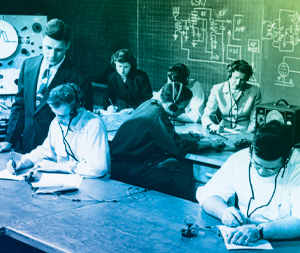

THE EDUCATIONAL LEGACY
One of the Penn State College of Engineering’s lasting legacies has been in preparing thousands of engineering students for successful careers in industry, government, academia, and beyond.
As early as 1902, employers like General Electric, Westinghouse, and the Pennsylvania Railroad were clamoring to hire more engineering graduates from Penn State.
“We should very much like to get a good representation from your class in electrical engineering this year, and we will agree to place in our testing department at least six of your men.”
“My object in writing is to find out if any of the 1902 boys would like to enter signal work?”
“More State men are wanted here and right now!”
Since 1896, the college has awarded nearly 129,000 degrees to more than 120,000 individuals and has annually ranked among the largest engineering programs in the nation in terms of student enrollment.
Penn State has long been an engineering education innovator not only at the undergraduate and graduate degree levels, but also through programs designed to reach a broader community of learners, an extension of its original Land Grant ideal.
By the end of the 1920s, the Department of Engineering Extension had given instruction on virtually every engineering topic to more than 30,000 Pennsylvania residents; work that would continue for decades.
With World War II on the horizon in the early 1940s, Penn State’s Engineering Science and Management Defense Training Program provided engineering training to more than 10,000, the largest enrollment of any institution in the country. During the war, several large corporations like Curtiss-Wright contracted with the school to train women for jobs as engineering technicians in defense plants.
In the 1980s, the new Women in Engineering Program and Minority Engineering Program — later renamed as the Multicultural Engineering Program – adopted outreach strategies to attract more women and underrepresented students into engineering.
It’s work that continues today as a key strategic focus of the college.
“It is important that we ensure we are leaders in equity and inclusion, opening doors to students and faculty from broad, diverse backgrounds and ensuring a collegial, welcoming climate for everyone,” said Justin Schwartz, Harold and Inge Marcus Dean of Engineering, as he announced Tonya Peeples as the college’s first associate dean for equity and inclusion in 2018. “I want to see all Penn State students, post-docs, and faculty reach their highest levels of achievement.”
In their words
“My heroes growing up were engineers. I wanted to be an engineer, and that’s why I came to Penn State.”
Guion S. Bluford Jr. ’64, who in 1983 became the first African American in space. Bluford served on four NASA Space Shuttle missions.




